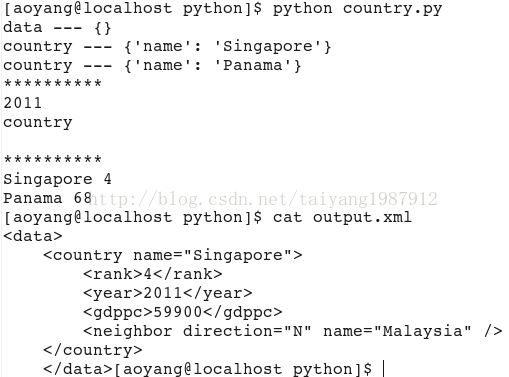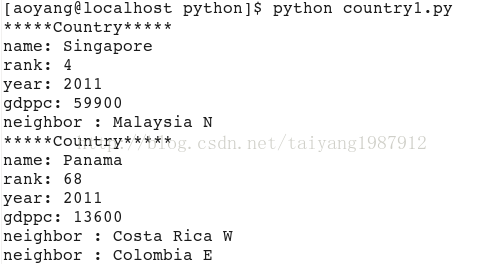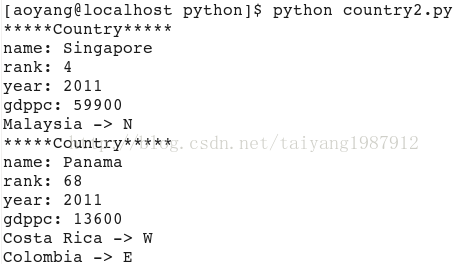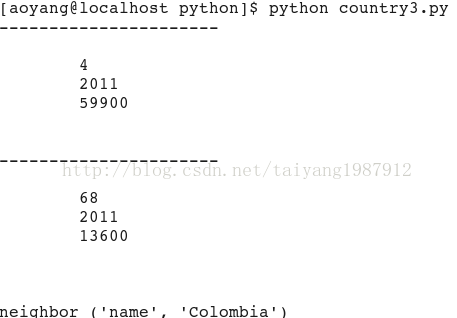用Python解析XML的几种常见方法的介绍
一、简介
XML(eXtensible Markup Language)指可扩展标记语言,被设计用来传输和存储数据,已经日趋成为当前许多新生技术的核心,在不同的领域都有着不同的应用。它是web发展到一定阶段的必然产物,既具有SGML的核心特征,又有着HTML的简单特性,还具有明确和结构良好等许多新的特性。
python解析XML常见的有三种方法:一是xml.dom.*模块,它是W3C DOM API的实现,若需要处理DOM API则该模块很适合,注意xml.dom包里面有许多模块,须区分它们间的不同;二是xml.sax.*模块,它是SAX API的实现,这个模块牺牲了便捷性来换取速度和内存占用,SAX是一个基于事件的API,这就意味着它可以“在空中”处理庞大数量的的文档,不用完全加载进内存;三是xml.etree.ElementTree模块(简称 ET),它提供了轻量级的Python式的API,相对于DOM来说ET 快了很多,而且有很多令人愉悦的API可以使用,相对于SAX来说ET的ET.iterparse也提供了 “在空中” 的处理方式,没有必要加载整个文档到内存,ET的性能的平均值和SAX差不多,但是API的效率更高一点而且使用起来很方便。
二、详解
解析的xml文件(country.xml):
在CODE上查看代码片派生到我的代码片
<?xml version="1.0"?>
<data>
<country name="Singapore">
<rank>4</rank>
<year>2011</year>
<gdppc>59900</gdppc>
<neighbor name="Malaysia" direction="N"/>
</country>
<country name="Panama">
<rank>68</rank>
<year>2011</year>
<gdppc>13600</gdppc>
<neighbor name="Costa Rica" direction="W"/>
<neighbor name="Colombia" direction="E"/>
</country>
</data>
1、xml.etree.ElementTree
ElementTree生来就是为了处理XML,它在Python标准库中有两种实现:一种是纯Python实现的,如xml.etree.ElementTree,另一种是速度快一点的xml.etree.cElementTree。注意:尽量使用C语言实现的那种,因为它速度更快,而且消耗的内存更少。
在CODE上查看代码片派生到我的代码片
try:
import xml.etree.cElementTree as ET
except ImportError:
import xml.etree.ElementTree as ET
这是一个让Python不同的库使用相同API的一个比较常用的办法,而从Python 3.3开始ElementTree模块会自动寻找可用的C库来加快速度,所以只需要import xml.etree.ElementTree就可以了。
在CODE上查看代码片派生到我的代码片
#!/usr/bin/evn python
#coding:utf-8
try:
import xml.etree.cElementTree as ET
except ImportError:
import xml.etree.ElementTree as ET
import sys
try:
tree = ET.parse("country.xml") #打开xml文档
#root = ET.fromstring(country_string) #从字符串传递xml
root = tree.getroot() #获得root节点
except Exception, e:
print "Error:cannot parse file:country.xml."
sys.exit(1)
print root.tag, "---", root.attrib
for child in root:
print child.tag, "---", child.attrib
print "*"*10
print root[0][1].text #通过下标访问
print root[0].tag, root[0].text
print "*"*10
for country in root.findall('country'): #找到root节点下的所有country节点
rank = country.find('rank').text #子节点下节点rank的值
name = country.get('name') #子节点下属性name的值
print name, rank
#修改xml文件
for country in root.findall('country'):
rank = int(country.find('rank').text)
if rank > 50:
root.remove(country)
tree.write('output.xml')
运行结果:

参考:https://docs.python.org/2/library/xml.etree.elementtree.html
2、xml.dom.*
文件对象模型(Document Object Model,简称DOM),是W3C组织推荐的处理可扩展置标语言的标准编程接口。一个 DOM 的解析器在解析一个XML文档时,一次性读取整个文档,把文档中所有元素保存在内存中的一个树结构里,之后你可以利用DOM 提供的不同的函数来读取或修改文档的内容和结构,也可以把修改过的内容写入xml文件。python中用xml.dom.minidom来解析xml文件,例子如下:
在CODE上查看代码片派生到我的代码片
#!/usr/bin/python
#coding=utf-8
from xml.dom.minidom import parse
import xml.dom.minidom
# 使用minidom解析器打开XML文档
DOMTree = xml.dom.minidom.parse("country.xml")
Data = DOMTree.documentElement
if Data.hasAttribute("name"):
print "name element : %s" % Data.getAttribute("name")
# 在集合中获取所有国家
Countrys = Data.getElementsByTagName("country")
# 打印每个国家的详细信息
for Country in Countrys:
print "*****Country*****"
if Country.hasAttribute("name"):
print "name: %s" % Country.getAttribute("name")
rank = Country.getElementsByTagName('rank')[0]
print "rank: %s" % rank.childNodes[0].data
year = Country.getElementsByTagName('year')[0]
print "year: %s" % year.childNodes[0].data
gdppc = Country.getElementsByTagName('gdppc')[0]
print "gdppc: %s" % gdppc.childNodes[0].data
for neighbor in Country.getElementsByTagName("neighbor"):
print neighbor.tagName, ":", neighbor.getAttribute("name"), neighbor.getAttribute("direction")
运行结果:

参考:https://docs.python.org/2/library/xml.dom.html
3、xml.sax.*
SAX是一种基于事件驱动的API,利用SAX解析XML牵涉到两个部分:解析器和事件处理器。其中解析器负责读取XML文档,并向事件处理器发送事件,如元素开始跟元素结束事件;而事件处理器则负责对事件作出相应,对传递的XML数据进行处理。python中使用sax方式处理xml要先引入xml.sax中的parse函数,还有xml.sax.handler中的ContentHandler。常使用在如下的情况下:一、对大型文件进行处理;二、只需要文件的部分内容,或者只需从文件中得到特定信息;三、想建立自己的对象模型的时候。
ContentHandler类方法介绍
(1)characters(content)方法
调用时机:
从行开始,遇到标签之前,存在字符,content的值为这些字符串。
从一个标签,遇到下一个标签之前, 存在字符,content的值为这些字符串。
从一个标签,遇到行结束符之前,存在字符,content的值为这些字符串。
标签可以是开始标签,也可以是结束标签。
(2)startDocument()方法
文档启动的时候调用。
(3)endDocument()方法
解析器到达文档结尾时调用。
(4)startElement(name, attrs)方法
遇到XML开始标签时调用,name是标签的名字,attrs是标签的属性值字典。
(5)endElement(name)方法
遇到XML结束标签时调用。
在CODE上查看代码片派生到我的代码片
#coding=utf-8
#!/usr/bin/python
import xml.sax
class CountryHandler(xml.sax.ContentHandler):
def __init__(self):
self.CurrentData = ""
self.rank = ""
self.year = ""
self.gdppc = ""
self.neighborname = ""
self.neighbordirection = ""
# 元素开始事件处理
def startElement(self, tag, attributes):
self.CurrentData = tag
if tag == "country":
print "*****Country*****"
name = attributes["name"]
print "name:", name
elif tag == "neighbor":
name = attributes["name"]
direction = attributes["direction"]
print name, "->", direction
# 元素结束事件处理
def endElement(self, tag):
if self.CurrentData == "rank":
print "rank:", self.rank
elif self.CurrentData == "year":
print "year:", self.year
elif self.CurrentData == "gdppc":
print "gdppc:", self.gdppc
self.CurrentData = ""
# 内容事件处理
def characters(self, content):
if self.CurrentData == "rank":
self.rank = content
elif self.CurrentData == "year":
self.year = content
elif self.CurrentData == "gdppc":
self.gdppc = content
if __name__ == "__main__":
# 创建一个 XMLReader
parser = xml.sax.make_parser()
# turn off namepsaces
parser.setFeature(xml.sax.handler.feature_namespaces, 0)
# 重写 ContextHandler
Handler = CountryHandler()
parser.setContentHandler(Handler)
parser.parse("country.xml")
运行结果:

4、libxml2和lxml解析xml
libxml2是使用C语言开发的xml解析器,是一个基于MIT License的免费开源软件,多种编程语言都有基于它的实现,python中的libxml2模块有点小不足的是:xpathEval()接口不支持类似模板的用法,但不影响使用,因libxml2采用C语言开发的,因此在使用API接口的方式上难免会有点不适应。
在CODE上查看代码片派生到我的代码片
#!/usr/bin/python
#coding=utf-8
import libxml2
doc = libxml2.parseFile("country.xml")
for book in doc.xpathEval('//country'):
if book.content != "":
print "----------------------"
print book.content
for node in doc.xpathEval("//country/neighbor[@name = 'Colombia']"):
print node.name, (node.properties.name, node.properties.content)
doc.freeDoc()

lxml是以libxml2为基础采用python语言开发的,从使用层面上说比lxml更适合python开发者,且xpath()接口支持类似模板的用法。
在CODE上查看代码片派生到我的代码片
#!/usr/bin/python
#coding=utf-8
import lxml.etree
doc = lxml.etree.parse("country.xml")
for node in doc.xpath("//country/neighbor[@name = $name]", name = "Colombia"):
print node.tag, node.items()
for node in doc.xpath("//country[@name = $name]", name = "Singapore"):
print node.tag, node.items()

三、总结
(1)Python中XML解析可用的类库或模块有xml、libxml2 、lxml 、xpath等,需要深入了解的还需参考相应的文档。
(2)每一种解析方式都有自己的优点和缺点,选择前可以综合各个方面的性能考虑。
(3)若有不足,请留言,在此先感谢!

Hot AI Tools

Undresser.AI Undress
AI-powered app for creating realistic nude photos

AI Clothes Remover
Online AI tool for removing clothes from photos.

Undress AI Tool
Undress images for free

Clothoff.io
AI clothes remover

Video Face Swap
Swap faces in any video effortlessly with our completely free AI face swap tool!

Hot Article

Hot Tools

Notepad++7.3.1
Easy-to-use and free code editor

SublimeText3 Chinese version
Chinese version, very easy to use

Zend Studio 13.0.1
Powerful PHP integrated development environment

Dreamweaver CS6
Visual web development tools

SublimeText3 Mac version
God-level code editing software (SublimeText3)

Hot Topics
 1386
1386
 52
52
 Can vs code run in Windows 8
Apr 15, 2025 pm 07:24 PM
Can vs code run in Windows 8
Apr 15, 2025 pm 07:24 PM
VS Code can run on Windows 8, but the experience may not be great. First make sure the system has been updated to the latest patch, then download the VS Code installation package that matches the system architecture and install it as prompted. After installation, be aware that some extensions may be incompatible with Windows 8 and need to look for alternative extensions or use newer Windows systems in a virtual machine. Install the necessary extensions to check whether they work properly. Although VS Code is feasible on Windows 8, it is recommended to upgrade to a newer Windows system for a better development experience and security.
 How to run programs in terminal vscode
Apr 15, 2025 pm 06:42 PM
How to run programs in terminal vscode
Apr 15, 2025 pm 06:42 PM
In VS Code, you can run the program in the terminal through the following steps: Prepare the code and open the integrated terminal to ensure that the code directory is consistent with the terminal working directory. Select the run command according to the programming language (such as Python's python your_file_name.py) to check whether it runs successfully and resolve errors. Use the debugger to improve debugging efficiency.
 Can visual studio code be used in python
Apr 15, 2025 pm 08:18 PM
Can visual studio code be used in python
Apr 15, 2025 pm 08:18 PM
VS Code can be used to write Python and provides many features that make it an ideal tool for developing Python applications. It allows users to: install Python extensions to get functions such as code completion, syntax highlighting, and debugging. Use the debugger to track code step by step, find and fix errors. Integrate Git for version control. Use code formatting tools to maintain code consistency. Use the Linting tool to spot potential problems ahead of time.
 Is the vscode extension malicious?
Apr 15, 2025 pm 07:57 PM
Is the vscode extension malicious?
Apr 15, 2025 pm 07:57 PM
VS Code extensions pose malicious risks, such as hiding malicious code, exploiting vulnerabilities, and masturbating as legitimate extensions. Methods to identify malicious extensions include: checking publishers, reading comments, checking code, and installing with caution. Security measures also include: security awareness, good habits, regular updates and antivirus software.
 Python: Automation, Scripting, and Task Management
Apr 16, 2025 am 12:14 AM
Python: Automation, Scripting, and Task Management
Apr 16, 2025 am 12:14 AM
Python excels in automation, scripting, and task management. 1) Automation: File backup is realized through standard libraries such as os and shutil. 2) Script writing: Use the psutil library to monitor system resources. 3) Task management: Use the schedule library to schedule tasks. Python's ease of use and rich library support makes it the preferred tool in these areas.
 What is vscode What is vscode for?
Apr 15, 2025 pm 06:45 PM
What is vscode What is vscode for?
Apr 15, 2025 pm 06:45 PM
VS Code is the full name Visual Studio Code, which is a free and open source cross-platform code editor and development environment developed by Microsoft. It supports a wide range of programming languages and provides syntax highlighting, code automatic completion, code snippets and smart prompts to improve development efficiency. Through a rich extension ecosystem, users can add extensions to specific needs and languages, such as debuggers, code formatting tools, and Git integrations. VS Code also includes an intuitive debugger that helps quickly find and resolve bugs in your code.
 Python vs. JavaScript: The Learning Curve and Ease of Use
Apr 16, 2025 am 12:12 AM
Python vs. JavaScript: The Learning Curve and Ease of Use
Apr 16, 2025 am 12:12 AM
Python is more suitable for beginners, with a smooth learning curve and concise syntax; JavaScript is suitable for front-end development, with a steep learning curve and flexible syntax. 1. Python syntax is intuitive and suitable for data science and back-end development. 2. JavaScript is flexible and widely used in front-end and server-side programming.
 Golang vs. Python: Concurrency and Multithreading
Apr 17, 2025 am 12:20 AM
Golang vs. Python: Concurrency and Multithreading
Apr 17, 2025 am 12:20 AM
Golang is more suitable for high concurrency tasks, while Python has more advantages in flexibility. 1.Golang efficiently handles concurrency through goroutine and channel. 2. Python relies on threading and asyncio, which is affected by GIL, but provides multiple concurrency methods. The choice should be based on specific needs.




